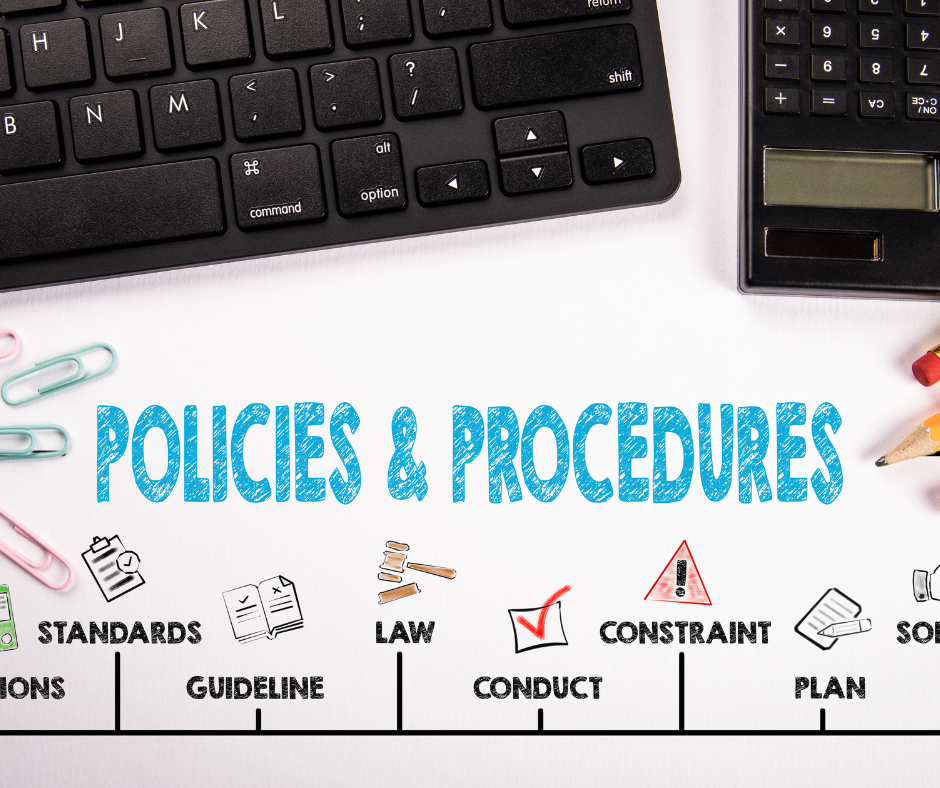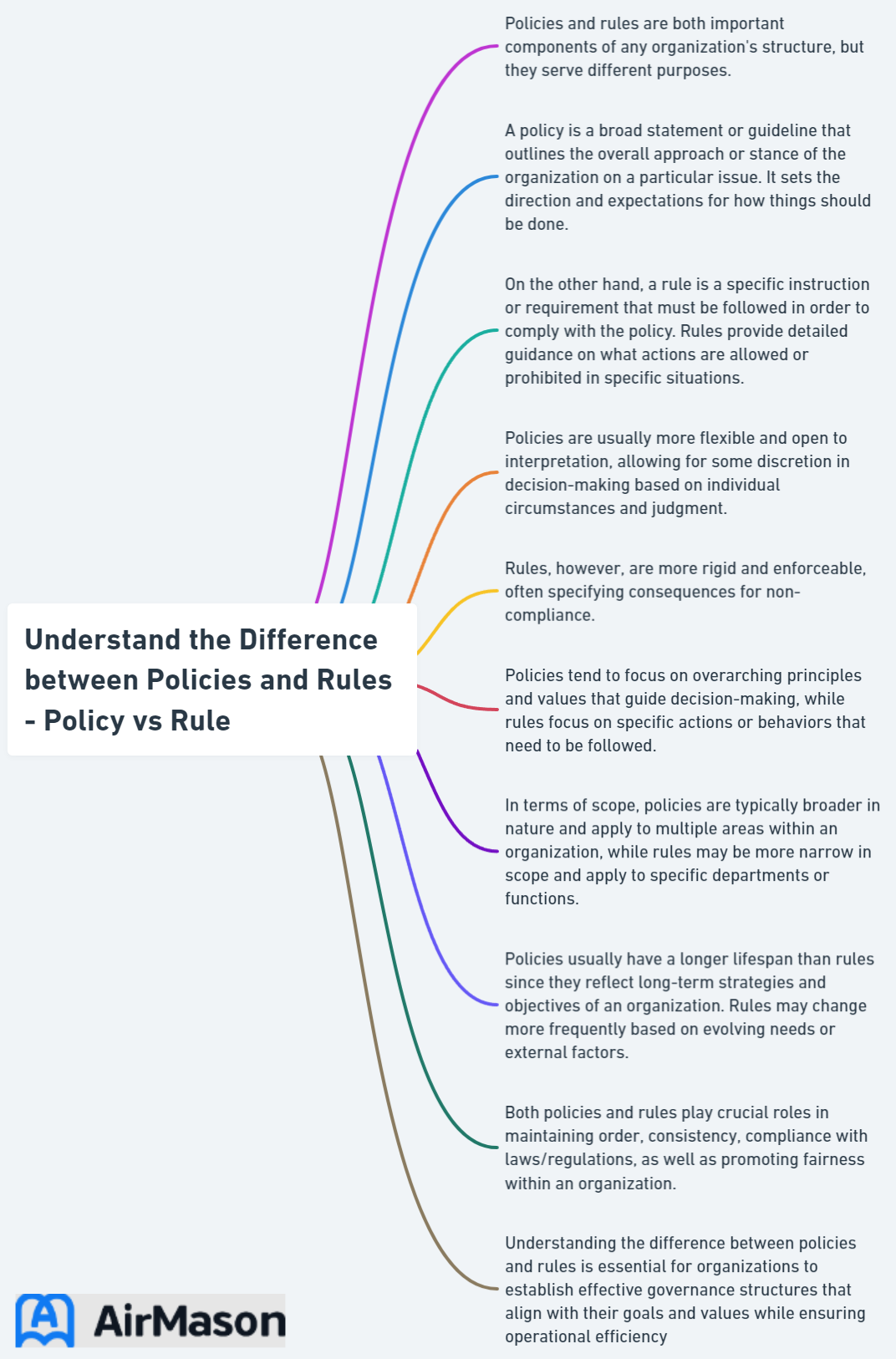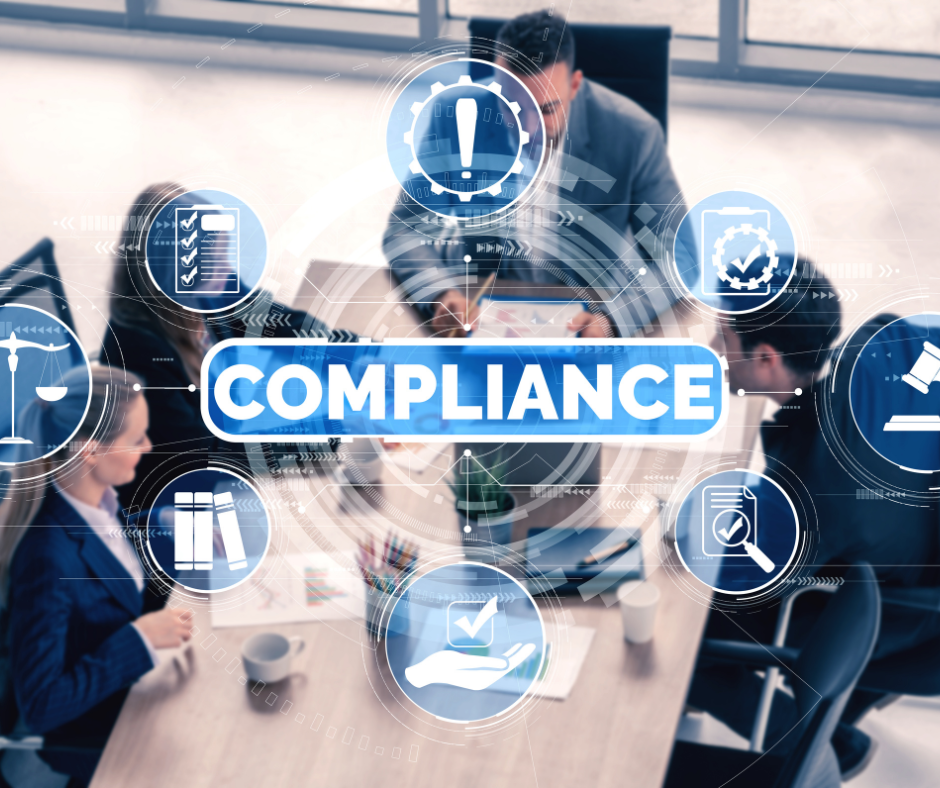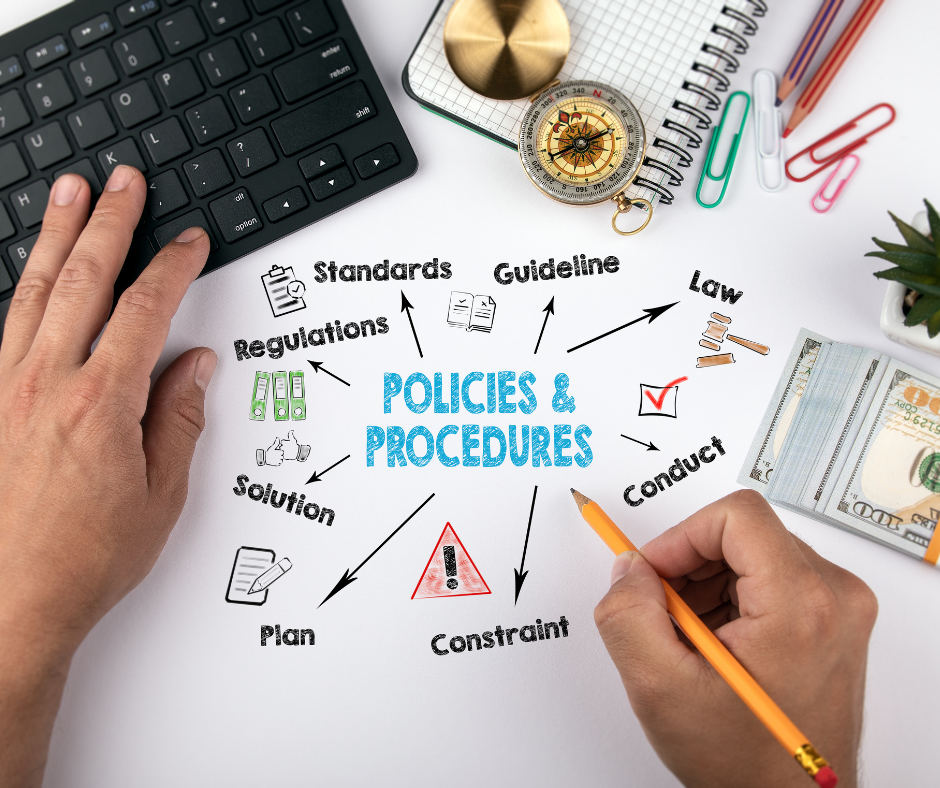
Imagine navigating a complex maze without a map or trying to participate in a game without knowing the rules. Sounds chaotic, right? In the world of organizations, policy vs rule serves as essential guides, providing direction and managing behavior to ensure smooth functioning and accomplishment of goals. Whether it’s a corporate setting, an educational institution, or even just a family unit, understanding the difference between policies and rules is crucial for success. In this blog post, we will explore the intricacies of policy vs rule, their similarities and differences, and the challenges organizations face when implementing and enforcing them.
Key Takeaways
- Policies and rules provide guidance for decision-making and behaviour within organizations.
- Policies have a wide scope, while rules are specific directives that outline permissible actions to maintain order.
- Successful implementation of policies and rules requires clear communication, understanding, training, balance between flexibility & rigidity. Ultimately promoting respectful behavior & ensuring smooth functioning.
Defining Policies
Policies are general statements that guide thinking and channel energy towards a particular direction, helping organizations achieve their business objectives. They act as a compass, steering decision-making processes and providing a framework for various actions within the organization. For any institution to function smoothly, from top management down to employees, discipline and consistency in actions are vital. This is where policies come into play.
Policies are often seen as standing plans that guide behavior and decision-making within organizations. They can be distinguished from rules, which are more specific statements that inform what must and must not be done. The policies difference becomes apparent when examining their:
- Scope
- Specificity
- Enforcement
- Flexibility
We will discuss these differences later in this blog post.

Purpose of a Policy
The purpose of a policy is to establish clear guidelines and principles that govern the actions and decisions within an organization. The “purpose of a policy” is to provide a framework that helps maintain consistency, fairness, and compliance with set standards. Policies serve as a roadmap, guiding employees on acceptable behavior and procedures, ensuring a harmonious and efficient working environment. Additionally, the purpose of a policy extends to risk management and legal compliance, helping organizations navigate complex regulations and mitigate potential issues. In essence, the “purpose of a policy” is to promote transparency, accountability, and a shared understanding of expectations among all stakeholders.
Purpose of Policies
Policies act as a high-level guide in decision-making processes, endorsing uniformity and confirming organizational values across different settings, including educational institutions. They streamline internal processes by offering guidance, ensuring adherence to relevant laws and regulations, and giving specific instructions for decision-making. This makes policies indispensable for the success of organizations, as they establish a foundation for rules and procedures.
There are various types of policies with distinct purposes, which can be applied in different organizational contexts. Some of the most common include:
- Distributive policies
- Redistributive policies
- Regulatory policies
- Constituent policies
These policies serve as the backbone of an organization, shaping its principles and guiding its actions towards achieving its objectives.
Examples of Policies
Examining some examples can help us gain a clearer understanding of the role policies play in organizations. Workplace safety policies, anti-discrimination policies, and environmental policies are just a few instances where policies provide a general framework for decision-making and behavior within an organization. These policies set the stage for a harmonious and productive work environment, ensuring that employees feel safe, valued, and respected.
Public policies, such as:
- housing policy
- education policy
- health policy
- tax policy
also demonstrate the crucial role policies play in shaping society and addressing public concerns. In the case of companies like Amazon and TATA Industries, their extensive policies enable them to operate in multiple industries and cater to a wide market, exemplifying the importance of well-defined policies in achieving business objectives.
Defining Rules
Conversely, rules are explicit directives outlining what actions are permissible and what are not, as a means of maintaining, regulating, and controlling the work environment. They are rigid and do not allow flexibility, which is one of the key differences between policies and rules. Violation of these rules may result in strict disciplinary actions. Rules provide the simplest form of planning. They don’t need to be altered regularly. They foster discipline within an organization.
Unlike policies, which provide a broader framework for decision-making, rules focus on maintaining order and discipline within an organization or domain. Rules play a crucial role in the overall functioning of the organization, ensuring that employees adhere to the established guidelines and procedures, ultimately contributing to the accomplishment of the organization’s goals.
Purpose of Rules
The task of rules is to regulate behaviour and uphold order within an organization or domain, an integral part of the organization’s overall functioning. They establish boundaries and limits that must be adhered to, ensuring compliance with the organization’s policies and facilitating efficient operations. In this sense, rules can be seen as the enforcers of policies, providing specific guidelines to ensure that the objectives laid out in the policies are met.
Rules are created for a lot of reasons. Primarily, they create a sense of order, help ensure compliance, and maintain discipline within a given system or community. Individuals who fail to comply with the organization’s regulations may face sanctions or penalties. Rules, therefore, act as a deterrent against non-compliant behavior and promote a harmonious and productive environment within the organization.
Examples of Rules
Let’s illustrate the concept of rules with a few examples:
- Dress codes
- Traffic regulations
- Classroom regulations
- Sports rules
These are instances where, under certain circumstances, rules are enforced to maintain order and ensure smooth functioning in various settings. In sports, rules govern how the game is conducted, delineating boundaries, scoring mechanisms, and player behavior.
In a restaurant setting, rules might require employees to:
- Adhere to personal hygiene and appearance guidelines
- Comply with uniform and dress code requirements
- Properly use safety equipment
- Comply with restaurant laws and regulations
- Follow cleaning policies and proper food preparation
These rules ensure the smooth operation of the workplace, maintaining a safe and efficient environment for both employees and customers.
Key Differences between Policies and Rules

Although policies and rules both guide behavior and decision-making within organizations, they exhibit differences in terms of:
- Scope
- Specificity
- Enforcement
- Flexibility
- Overall purpose and function
The subsequent sections will further dissect these differences and examine their influence on the distinct roles of policies and rules in organizational contexts.
Scope and Specificity
Policies have a broader scope and address a variety of matters pertinent to the organization as a whole. They provide a more comprehensive set of principles or frameworks that direct actions and behaviors. Policies allow for interpretation, which means they are open to varied interpretations or explanations of their meaning and require careful consideration to understand their intentions and implications.
In contrast, rules are more precise and exact, with limited opportunity for interpretation. They focus on particular behaviors, actions, or circumstances within a specific context, providing clear and precise guidelines for individuals or organizations to follow. The specificity of rules not only makes it easier for people to understand what is expected of them but also simplifies the monitoring and enforcement of compliance.
Enforcement and Flexibility
Policies are generally more malleable and permit interpretation and discretion in their enforcement, offering flexibility in decision-making and conduct. Infringement of policies may result in disciplinary measures or other repercussions that are decided based on the gravity of the infringement and the organization’s regulations. This flexibility allows organizations to adapt to changing circumstances and address unique situations while preserving the overall integrity of the policies.
Rules, on the other hand, are more stringent and have less scope for interpretation. They necessitate adherence to strict stipulations and have clear consequences for non-compliance, such as warnings, fines, or dismissal. The rigidity of rules helps maintain order and discipline within an organization, preventing chaos and ensuring smooth operations.
Purpose and Function
Policies provide overall guidance and direction, creating a framework for decision-making and facilitating compliance. They establish the standards, values, culture, and expectations of the organization, which in turn shape the specific rules that employees must observe. Policies lay the groundwork for rules, which are then put into effect and enforced in accordance with these policies.
In contrast, rules focus on maintaining order and discipline within an organization or domain. They provide specific guidelines that govern behavior and actions, ensuring that employees adhere to the established policies and procedures. Rules play a crucial role in the overall functioning of the organization, ensuring that all parties are cognizant of the same expectations and helping to maintain a harmonious and productive work environment.
How to Write a Policy
When tackling the task of creating a policy, understanding the essential steps of “how to write a policy” is crucial. Begin by clearly defining the purpose and scope of the policy, ensuring that its objectives align with organizational goals. Conduct thorough research to gather relevant information and insights that will inform the policy’s content. Structure the document logically, using concise language and providing clear guidelines for implementation. Seek input from key stakeholders to ensure inclusivity and garner diverse perspectives. Regularly review and update the policy as needed to adapt to changing circumstances, maintaining its effectiveness over time. Following these steps will help you craft a well-formulated and impactful policy for your organization.
Relationship between Policies and Rules

Policies and rules are interconnected, working together to steer behavior and decision-making within organizations. Policies serve as the foundation for rules, which are derived from and reinforce the enforcement of policies. In this sense, policies and rules can be seen as two sides of the same coin, working together to guide behavior and decision-making within organizations and ensure their smooth functioning and success.
Policies Inform Rules
Policies form the base for rules by providing guidelines, standards, and procedures that delineate the general requirements and conditions for decision-making. They explain the purpose, scope, and applicability of rules, helping to shape the rules and ensure compliance with laws and regulations. In this sense, policies act as the blueprint for rules, guiding their formulation and implementation.
Since rules stem from policies, they reinforce the enforcement of these policies and make certain that the objectives outlined in the policies are achieved. Rules, therefore, can be seen as the enforcers of policies, providing specific guidelines that govern behavior and actions, and ultimately contributing to the accomplishment of the organization’s goals.
Implementation and Compliance
The successful implementation and adherence to rules and policies are integral for organizational success. Adherence to policies and regulations facilitates organizational success in a variety of ways, including:
- Clarity and uniformity
- Risk management
- Operational efficiency
- Employee responsibility
- Organizational reputation
Effective implementation and compliance with rules and policies, therefore, form the backbone of any organization’s success.
Various tools and resources are available to facilitate policy and rule implementation and adherence, including:
- Policy management tools
- Compliance tools
- Policy management resources
- Implementation toolkits
These tools can help organizations ensure that their policies and rules are effectively communicated, understood, and followed by all members, ultimately contributing to the smooth functioning and success of the organization. In this process, they also provide guidance to the members.
Challenges in Implementing and Enforcing Policies and Rules

Organizations may face challenges in implementing and enforcing policies and rules. These can include ensuring clear communication and understanding of policies and rules, and striking a balance between flexibility and rigidity.
The following sections will further investigate these challenges and suggest possible strategies for overcoming them.
Communication and Understanding
For effective implementation, it’s vital to ensure clear communication and understanding of policies and rules. Without a thorough understanding of the expectations and requirements laid out in policies and rules, employees may struggle to comply, leading to inconsistencies, inefficiencies, and potential conflicts within the organization.
Employee training plays a vital role in comprehending and executing policies and rules. Training courses and accessible policy manuals can be utilized to ensure comprehension and compliance, fostering:
- Consistency
- Compliance
- Efficiency
- Communication
- Accountability
within the organization. By investing in employee training and clear communication, organizations can overcome the challenge of ensuring understanding and adherence to their policies and rules.
Balancing Flexibility and Rigidity

Establishing a balance between flexibility and rigidity is pivotal for adapting to evolving circumstances, while still upholding order. Flexibility in policy and rule enforcement allows for adaptability and responsiveness to changing circumstances. On the other hand, rigidity helps maintain order and discipline within an organization, preventing chaos and ensuring smooth operations.
Organizations, including government organizations, can achieve a balance between flexibility and rigidity by:
- Finding a compromise between stringent regulations and total autonomy
- Making themselves accessible to personnel who require additional direction
- Furnishing feedback
It is essential to acknowledge that flexibility should not be to the detriment of the organization’s values or principles. By striking this balance, organizations can effectively implement and enforce their policies and rules, ensuring success in both stable and changing environments while also working to ensure discipline.
Real-Life Examples of Policies and Rules in Action

The importance of policies and rules in various settings, such as workplace safety, education, and traffic management, is demonstrated through real-life examples of their application. For instance, a company’s code of conduct, recruitment policy, and internet and email policy are all examples of policies that establish expectations and suitable behavior in the workplace, fostering a respectful and inclusive work atmosphere.
Similarly, dress codes, traffic regulations, and classroom regulations exemplify rules that maintain order and ensure smooth functioning in various settings. In sports, rules govern how the game is conducted, delineating boundaries, scoring mechanisms, and player behavior. These real-life examples demonstrate the vital role policies and rules play in guiding behavior and decision-making in a wide range of contexts, ultimately contributing to the smooth functioning and success of organizations and societies.
Features of Policy
When exploring the landscape of governance and decision-making, understanding the features of policy becomes paramount. These features encompass the guidelines and principles that govern the formulation, implementation, and evaluation of policies. Examining the features of policy allows for a comprehensive analysis of its scope, impact, and effectiveness. From defining objectives and strategies to outlining regulatory frameworks, the features of policy shape the contours of societal norms and governmental actions. Exploring these features provides valuable insights into the intricate web of rules and guidelines that influence and direct various aspects of public and private life.
Summary
In conclusion, understanding the difference between policies and rules is essential for the success of any organization. Policies serve as high-level guidelines that provide a framework for decision-making, while rules are specific instructions that regulate behavior and maintain order. Although they share common objectives, policies and rules differ in key aspects such as scope and specificity, enforcement and flexibility, and purpose and function. By effectively implementing and adhering to rules and policies, organizations can ensure their smooth functioning and success in various settings and circumstances. So, the next time you encounter a policy or rule, remember that they are the building blocks of a well-functioning organization and society.
Frequently Asked Questions
What is the difference between a rule and policy?
Rules are specific and clearly defined standards that dictate behavior, while policies are general guiding statements used for decision-making. Rules provide direction on what must and must not be done, while policies serve as a guide to shape thinking and channel energy.
What is the difference between a rule and a procedure?
Rules set expectations for behavior, while procedures outline the steps necessary to complete a task or achieve a goal.
What is the purpose of a rule or policy?
A policy is a set of rules that establishes guidelines to ensure your organization and employees comply with regulations and achieve desired outcomes. It provides guidance and answers questions about employees’ roles and actions.
What are some examples of policies?
Examples of policies include workplace safety, anti-discrimination and environmental policies, which help guide decision-making and behavior within an organization.
What are some challenges in implementing and enforcing policies and rules?
Implementing and enforcing policies and rules can be a challenge as it requires clear communication and understanding, as well as the right balance between flexibility and inflexibility.